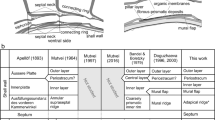Summary
The statocyst of otoplanids is enveloped by a bipartite capsule which consists of two different extracellular matrices. This capsule encircles three different types of aciliary cells: several peripherally located flattened parietal cells, one central statolith forming cell (lithocyte) and two clusters of accessory cells. Intracapsular lumina exist which are different from extracapsular intercellular spaces. The accessory cells most probably represent those structures that are mainly involved in nervous conduction. These cells extend cytoplasmatic processes towards different peripheral regions of the statocyst where processes of outer nerve cells penetrate the capsule. The statocyst does not seem to represent a more evolved equilibrium receptor system but may function as a relatively simple aciliary sense organ suitable for positive geotactic behaviour. The otoplanid statocyst corresponds to statocysts in other lithophorous proseriates but not to statocysts in other taxa of the free-living Plathelminthes. The monophyly of a taxon Lithophora within the Proseriata is corroborated by this autapomorphic characteristic.
Similar content being viewed by others
Abbreviations
- ac :
-
accessory cell(s)
- c :
-
capsule of the statocyst
- ce :
-
cerebrum
- ci :
-
cephalic intestine
- co :
-
capsule opening
- cp :
-
cell process(es) of accessory cell(s) and cell(s) containing filaments
- ecm :
-
extracellular matrix
- fc :
-
cell(s) containing filaments
- ic :
-
intercellular spaces within the capsule
- mc :
-
muscle cell(s)
- n :
-
lobed nucleus of the lithocyte
- nac :
-
nucleus (nuclei) of accessory cell(s)
- nc :
-
nerve cell(s)
- npc :
-
nucleus (nuclei) of parietal cell(s)
- pc :
-
parietal cell(s)
- s :
-
statolith
- sc :
-
statolith cell (lithocyte)
References
Ax P (1956) Monographie der Otoplanidae (Turbellaria). Morphologie und Systematik. Akad Wiss Lit Mainz Abh Math Naturwiss K1 Jhg 1955 Nr 13:499–796
Barnes RD (1980) Invertebrate Zoology (Fourth Edition). Holt-Saunders International Editions, Philadelphia Tokyo
Bedini C, Papi F (1974) Fine structure of the turbellarian epidermis. In: Riser NW, Morse MP (eds) Biology of the Turbellaria. McGraw-Hill Co, New York: 108–147
Brüggemann J, Ehlers U (1981) Ultrastruktur der Statocyste vonOtotyphlonemertes pallida (Keferstein, 1862) (Nemertini). Zoomorphology 97:75–87
Ehlers U (1985a) Das phylogenetische System der Platyhelminthes. G Fischer, Stuttgart New York
Ehlers U (1985b) Organisation der Statocyste vonRetronectes (Catenulida, Plathelminthes). Microfauna Marina 2:7–22
Ehlers U, Ehlers B (1977) Monociliary receptors in interstitial Proseriata and Neorhabdocoela (Turbellaria, Neoophora). Zoomorphologie 86:197–222
Ferrero E (1973) A fine structural analysis of the statocyst in Turbellaria Acoela. Zool Scr 2:5–16
Ferrero E, Bedini C, Lanfranchi A (1982) Ultrastructure of the statocyst in otoplanid turbellarians. Boll Zool 49 [Suppl]:76
Ferrero EA, Bedini C, Lanfranchi A (1985) An ultrastructural account of otoplanid Turbellaria neuroanatomy. II. The statocyst design: evolutionary and functional implications. Acta Zool (Stockholm) 66:75–87
Giesa S (1966) Die Embryonalentwicklung vonMonocelis fusca Oersted (Turbellaria, Proseriata). Z Morphol Oekol Tiere 57:137–230
Hallez P (1910) Un nouveau type d'Alloiocoele (Bothriomolus constrictus n g n sp). Arch Zool Exp Gen Ser 5, 3:611–664
Hanson ED (1977) The origin and early evolution of animals. Wesleyan University Press, Middletown, Connecticut, Pitman, London Melbourne
Hori I (1979) Structure and regeneration of the planarian basal lamina: an ultrastructural study. Tissue Cell 11:611–621
Hyman LH (1951) The Invertebrates. Platyhelminthes and Rhynchocoela. The acoelomate Bilateria. McGraw-Hill, New York Toronto London
Ivanov VP, Mamkaev YuV, Pevzner RA (1972) Electron microscopic study on the statocyst in the acoelan TurbellariaConvoluta convoluta. Zh Evol Biokhim Fiziol 8:189–193 (in Russian)
Marcus E (1950) Turbellaria Brasileiros (8). Bol Fac Fil Cienc Letr Univ São Paulo, Zoologia 15:5–191
Maristo L (1938) Beiträge zur Kenntnis der Monocelidinen (Turbellaria, Alloeocoela). Ann Zool Soc Zool-Bot Fenn Vanamo 6, 3:1–69
Martens PM, Schockaert ER (1988) Phylogeny of the digonoporid Proseriata. Fortschr Zool 36:399–403
Midelburg A (1908) Zur Kenntnis der Monocelididae. Z Wiss Zool 88:199–226
Pedersen KJ (1961) Studies on the nature of planarian connective tissue. Z Zellforsch 53:569–608
Sopott-Ehlers B (1984) Feinstruktur pigmentierter und unpigmentierter Photoreceptoren bei Proseriata (Plathelminthes). Zool Scr 13:9–17
Sopott-Ehlers B (1985) The phylogenetic relationships within the Seriata (Platyhelminthes). In: Conway Morris S, George JD, Gibson R, Platt HM (eds) The origins and relationships of lower invertebrates. Oxford Univ Press, Oxford: 159–167
Sopott-Ehlers B (1986) Die Feinstruktur der Sehkolben und der Lamellarkörper vonParotoplana capitata (Plathelminthes, Proseriata). Zoomorphology 106:44–48
Tajika K-I (1982) Morphologisch-phylogenetische Untersuchungen an der Familie Coelogynoporidae (Turbellaria, Proseriata). J Fac Sci Hokkaido Univ Ser 6 23:13–62
von Hofsten N (1907) Studien über Turbellarien aus dem Berner Oberland. Z Wiss Zool 85:391–654
von Hofsten N (1918) Anatomie, Histologie und systematische Stellung vonOtoplana intermedia du Plessis. Zool Bidr Uppsala 7:1–74
Author information
Authors and Affiliations
Rights and permissions
About this article
Cite this article
Ehlers, U., Sopott-Ehlers, B. Organization of statocysts in the Otoplanidae (Plathelminthes): an ultrastructural analysis with implications for the phylogeny of the Proseriata. Zoomorphology 109, 309–318 (1990). https://doi.org/10.1007/BF00803571
Received:
Issue Date:
DOI: https://doi.org/10.1007/BF00803571




